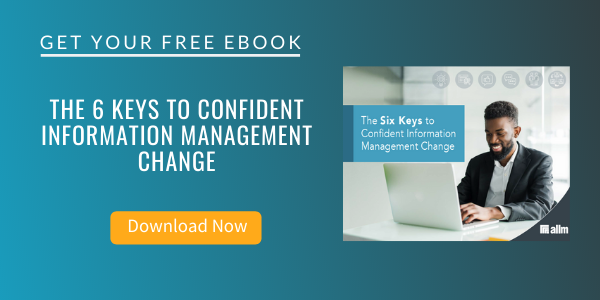
How to Become an Internal Influencer for Change
Change Management | AIIM Conference
Enacting change is easier when you don’t have to go at it alone. In fact, a major factor in the success of organizational change comes down to internal buy-in with your co-workers. The more internal advocates you have on your side, the easier that positive change can spread quickly and efficiently. The old adage about there being ‘strength in numbers’ holds true when it comes to change management.
So, how can you become an Internal Influencer and gain internal advocates for change? It may surprise you to learn that all it takes are some skills that can be applied with little to no cost beyond the investment of time.
This was the subject of Kevin Craine's recent interview with Natalie Austin, Records Manager for Atlanta Housing. Natalie recently spoke at The AIIM Conference 2020 in Dallas, TX on how to leverage your social IQ, identify and target your internal audience, and gain their buy-in for positive organizational change. Kevin interviewed Natalie about her session and the key takeaways.
Interview with Natalie Austin
Kevin Craine: Hello, Natalie. Thank you for chatting with me today. You are giving a session at AIIM20 this year. Can you tell us a little bit more, what is the topic of your session, and what will it cover?
Natalie Austin: Well, the topic of my session is on becoming an internal influencer. The title is Becoming an Internal Influencer; Leveraging Your Social IQ to Effect Change.
Kevin Craine: Why is that important? Why should we be concerned about being a social influencer? What do you mean by that?
Natalie Austin: Well, most of the focus when we talk about our projects or implementation, it's usually about getting executives to buy into a project. User adoption is sort of at the bottom of the process, right. We usually presume that if we can get everybody trained on the system, if we get the messages out, if we get the memos out, then everyone will get on board. That doesn't usually happen, because even though the users are at the end of an implementation, they're the ones who really drive the adoption.
Natalie Austin: When you have lots of complaints about the system, that's when the discussion starts about getting another system, getting something that works. That's also when we start getting people who set up secondary repositories. I've seen everything from people keeping manual copies of everything because they don't want to bother the searching for things in the system, to keeping hidden file drawers, all of that. It's really about, how can you engage with your users, how can you find the people who are influencers amongst their own team and get people on board.
Kevin Craine: I hear what you're saying is even the best strategies and technologies aren't much good if folks don't actually use them.
Natalie Austin: Oh, absolutely. It's the human factor that gets lost in the classic project planning. We're all taught these implementations will work if we have all of this buy-in. The messaging is not for the average user. The user gets told what to do, they're not engaged on how it's designed, they're not really engaged on how it affects their everyday workflows, and so you get a lot of resistance internally, and once you get that, once it solidifies, you don't get adoption.
Kevin Craine: How do I do it, is my next question. What are some of the techniques that you'll be talking about?
Natalie Austin: Well, we'll be talking about identifying the groups in your organization, the people that are already internal influencers, how to engage with them, engaging with them on multiple levels, and identifying exactly what are the pain points that they're having with whatever your system is. Because it's those pain points that are driving them to set up alternative systems, then complain to their managers and bosses. If we can offer them a solution, then we can turn them into information management advocates.
Kevin Craine: What about C-Suite level support? What are your recommendations for us to engage that level of support for our efforts?
Natalie Austin: Well, I think it's the same. Your users are your administrators and your managers, and some of those are going to be your influencers as well. We forget that they listen to their staff around them. If their support staff is really happy with the system, if they're engaged with it, then the C-Suite doesn't have any objections or isn't actively looking to replace it.
Kevin Craine: Natalie, one last question before I let you go. What's your biggest challenge with respect to information management at Atlanta Housing that you're facing today?
Natalie Austin: Well, I think the biggest is the speed of change with things going to the Cloud, we're a quasi-governmental sort of agency, and so there's a lot of challenges when you're looking at information management and content systems, and really looking at moving heavily from onsite, on-premises applications to Cloud applications, and then how do we manage the information flow, the retention, and the governance around all of that. That's something that we're looking at right now.
Kevin Craine: Natalie, thank you so much for taking the time out of your day to chat with us.
Some Practical Advice
If it’s just not an option to attend, don't worry, Natalie still has some advice on this topic for you.
Kevin Craine: For folks that can't attend the conference this year, what's one takeaway that you can give to us now, that is part of what you'll be talking about in your session?
Natalie Austin: Well, you have people in your organization already, and you have resources that are low cost or free like social media, your internet, your break rooms, and other areas where you can engage with people. You can be an advocate, and you can work on what their individual problems are, and then take those people and use them as internal influencers.



